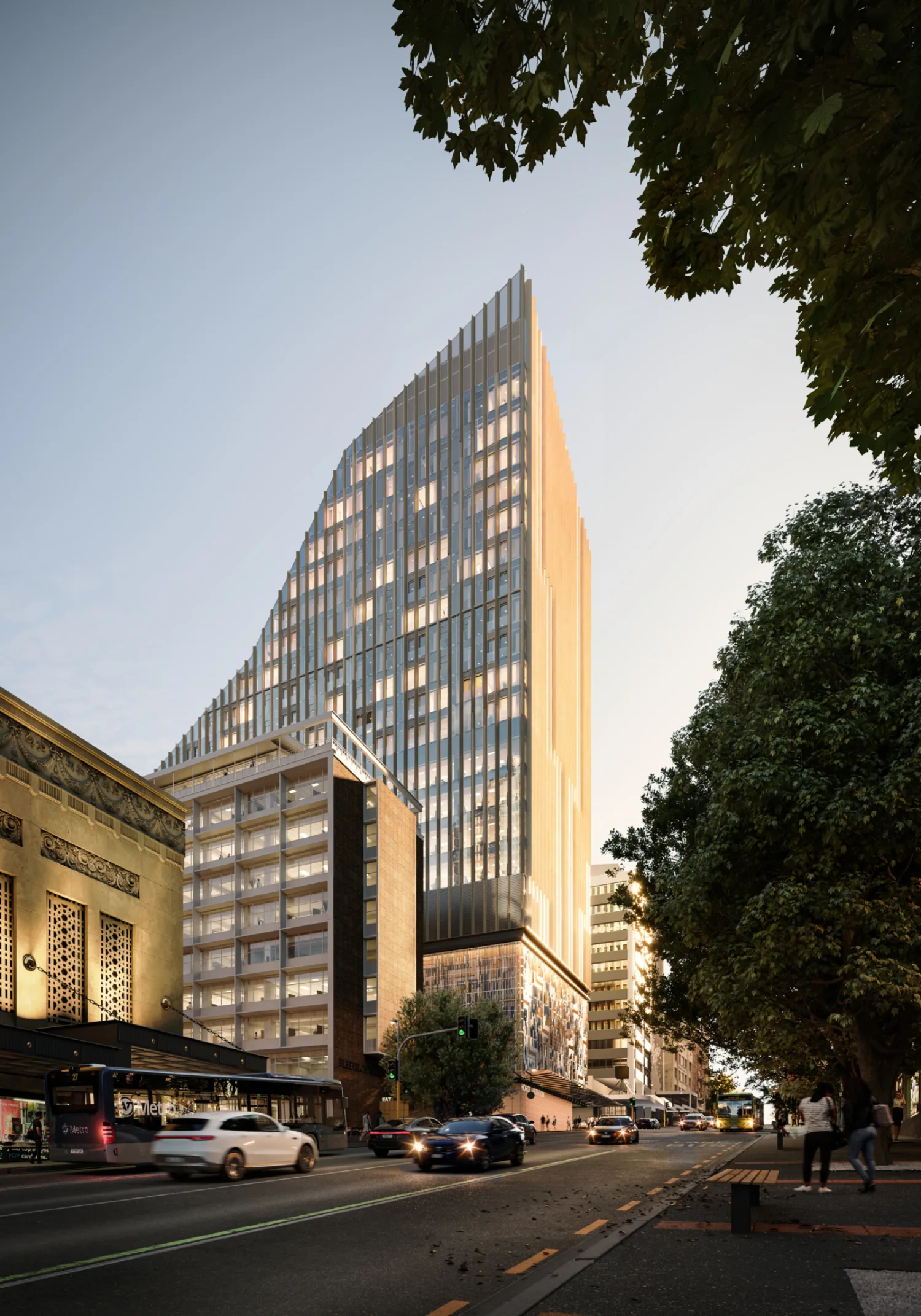Human-centric architecture

A Human-centric approach: the architectural vision behind The Symphony Centre development
The Symphony Centre development is designed to give Tāmaki Makaurau a vibrant, revitalised precinct that enriches the city’s iconic Aotea Arts Quarter.
Encompassing The Symphony Centre, to be built over Te Waihorotiu Station, the restoration and upcycle of Bledisloe House, and the activation of restaurant and retail destination a unique public space The Lanes, a new the development is a beacon of modern, artful and considered design that will change the heart of the city.
We explore the architectural and design vision behind each iconic pillar of the development to uncover how a human-centric approach has delivered a unified concept grounded in culture and connection.
The Symphony Centre - Bruno Mendes, Woods Bagot
Our inspiration for The Symphony Centre comes from the vision of providing a dynamic urban living environment where residents can seamlessly integrate their daily activities - living, working, and leisure - within a single structure.
A key aspect of the development concept is a human-centered design approach. We prioritisze creating spaces that foster collaboration, interaction, flexibility, and agility, ensuring that the needs and desires of our future users are met, to accommodate diverse user groups, and to ultimately promote a sense of community and connection.
Another key component of our concept reflects the intention to integrate various cultural narratives and elements within the development. The rich historical fabric of the surrounding Aotea Arts Quarter, the distinctive characteristics of the Waitemata cliffs, and the sandstone prevalent in the area all contribute to the artistry behind our design. By incorporating these contextual influences from Tāmaki Makaurau, we aim to create a building that is not only architecturally striking but also deeply rooted in the local heritage and environment
The Symphony Centre's design is a beautiful amalgamation of practical needs and cultural narratives. Its vertical mixed-use approach combines various facilities like retail shops, food and beverage offerings, living and working spaces, and an incubator space in one building. This design puts a significant emphasis on creating a pedestrian-friendly environment with direct connectivity to local destinations and a focus on public spaces.
A significant feature of the Symphony Centre is the seamless transition between its interior and exterior, forming a continuous ground plane that encourages interaction and movement. This design aspect aims to bring the identity and presence of Aotea Arts Qurter to the street/precinct edges and provide an opportunity for additional cultural programming in the city.
The most striking feature of the building's exterior design will be its unique form. Inspired by the concept of a 'landform' rather than a typical architectural approach, the massing of the building adheres to the challenges of shadowing restrictions onto Aotea Square. This approach gives the building a unique aesthetic that integrates seamlessly with the Aotea Quarter’s cultural and entertainment offerings.

Bledisloe House David Phillips, Peddlethorp
Bledisloe House represents a distinctive period of post war development, with a Modernist Le Corbusian slab structure and a highly organised façade with raw finished metal windows particular to this time.
The restoration and upcycle concept for Bledisloe ensures this unique identity is celebrated. The existing modernist form and features of the building have guided the concept design with any new additions looking to compliment its heritage.
A key restoration and design feature of this heritage-listed building includes a carefully considered approach to the façade. At ground level it will be replaced with a high-quality steel joinery system, one that keeps rhythm with the heritage façade above. The intensity of the glazing mullions will contract and expand to draw attention to particular areas of the facade.
Key to the occupation and activation of Bledisloe House will be the reentrant internal lane through the building bringing the identity of the Laneway inside. Reentrant spaces are signposted with elegant metal canopies, drawing people in through large steel pivot doors, over four metres in height, that will allow a porous movement into the building. These doors will extend up to the building’s existing in situ concrete structure which is revealed and celebrated as part of the refurbishment.
The people of Aotea Arts Quarter will be what the soul of the place emanates from. Bledisloe House, with The Lanes, will provide a place for the artist and patrons to eat and entertain with restaurants and bars serving from dawn through into the night. The interiors of Bledisloe House will be immaculately curated with fittings and furniture that will produce spaces the creative industries would love to occupy or frequent.

The Lanes, Henry Crothers, Landlab
The Lanes creates a new vibrant public layer to the development, creating pedestrian activity, accessibility, greenery, and the realisation of a prosperous inner city neighborhood.
It is a critical space which knits together Aotea Square, Te Waihorotiu Station, Bledisloe House, Wellesley Street, Mayoral Drive and the new Symphony Centre, creating a cohesive public realm which strengthens Aotea Arts Quarter as a whole.
Key design drivers are universal accessibility and inclusion. The Lanes is connected to the busiest node of our city’s new public transport and is intended for all of Auckland to enjoy. By catering for a mixture of public occupation and commercial activation, the project seeks to create a vibrant public space which responds to the energy provided by the new Symphony Centre and the revitalised Bledisloe House.
The design and flow of The Lanes also expresses the underlying topography of the site in the form of a layered space, integrating movement, connectivity and place making. We are working with mana whenua artists Graham Tipene, Ted Ngataki and Maaka Potini to express Te Ao Maori concepts and embed this destination into its unique place in the world.










